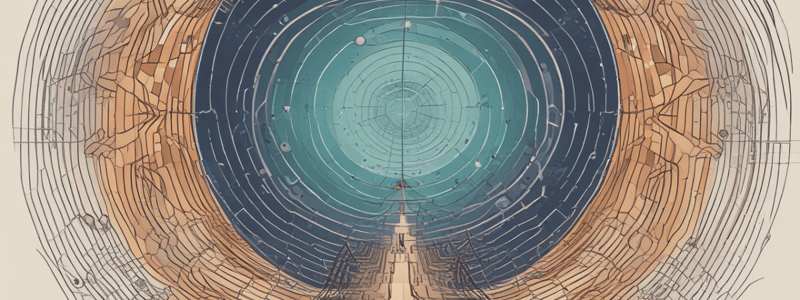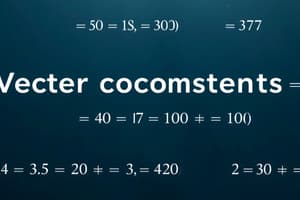Podcast
Questions and Answers
What is a physical quantity?
What is a physical quantity?
- A quantity that can be explained by laws but not measured.
- A quantity that can be measured and explained in terms of laws. (correct)
- A quantity that can only be measured but not explained by laws.
- A quantity that cannot be measured or explained by laws.
What is a fundamental quantity?
What is a fundamental quantity?
- A quantity that is derived from other quantities.
- A quantity that is independent of other quantities. (correct)
- A quantity that is not measurable.
- A quantity that is dependent on other quantities.
What is a vector quantity?
What is a vector quantity?
- A quantity that has both magnitude and direction. (correct)
- A quantity that has magnitude only.
- A quantity that has neither magnitude nor direction.
- A quantity that has direction only.
What is a derived quantity?
What is a derived quantity?
What is an example of a derived quantity?
What is an example of a derived quantity?
When refractive index is defined as Velocity of light in air/Velocity of light in medium, what does it imply about the velocity of light?
When refractive index is defined as Velocity of light in air/Velocity of light in medium, what does it imply about the velocity of light?
Which of the following is a derived quantity if speed and time are chosen as fundamental quantities?
Which of the following is a derived quantity if speed and time are chosen as fundamental quantities?
A scalar quantity can have a negative:
A scalar quantity can have a negative:
Strain is a measure of:
Strain is a measure of:
What is the minimum number of fundamental quantities required to express all other quantities in mechanics?
What is the minimum number of fundamental quantities required to express all other quantities in mechanics?
What is the fundamental unit of mass in the CGS system?
What is the fundamental unit of mass in the CGS system?
Which system of units uses foot, pound, and second as fundamental units?
Which system of units uses foot, pound, and second as fundamental units?
What is the unit of force in the FPS system?
What is the unit of force in the FPS system?
What is the standard unit of length in the CGS system?
What is the standard unit of length in the CGS system?
Which of the following is a fundamental quantity in the MKS system?
Which of the following is a fundamental quantity in the MKS system?
What is the unit of length in the CGS system?
What is the unit of length in the CGS system?
What is the prefix for 10^-6 in the S.I. system?
What is the prefix for 10^-6 in the S.I. system?
What is the fundamental unit of time in the MKS system?
What is the fundamental unit of time in the MKS system?
Which of the following is a unit of mass in the MKS system?
Which of the following is a unit of mass in the MKS system?
What is the unit of length in the FPS system?
What is the unit of length in the FPS system?
What was the initial definition of the unit of time, the second, based on?
What was the initial definition of the unit of time, the second, based on?
What is the relationship between the least count of a screw gauge and the accuracy of measurement?
What is the relationship between the least count of a screw gauge and the accuracy of measurement?
What is a characteristic of a physical quantity that remains constant?
What is a characteristic of a physical quantity that remains constant?
What is the effect of changing the unit of measurement on the significant figures of a physical quantity?
What is the effect of changing the unit of measurement on the significant figures of a physical quantity?
What is a characteristic of a repetitive phenomenon that can be used to measure time?
What is a characteristic of a repetitive phenomenon that can be used to measure time?
What is the equivalent value of 1 fermi in terms of meters?
What is the equivalent value of 1 fermi in terms of meters?
What is the mass of an electron in terms of kilograms?
What is the mass of an electron in terms of kilograms?
What is the equivalent value of 1 angstrom in terms of meters?
What is the equivalent value of 1 angstrom in terms of meters?
What is the value of 1 Chandra Shekhar unit in terms of kilograms?
What is the value of 1 Chandra Shekhar unit in terms of kilograms?
What is the equivalent value of 1 year in terms of time?
What is the equivalent value of 1 year in terms of time?
Study Notes
Practical Units
- Length units include fermi (1 fm = 10^-15 m) and X-ray unit (1 XU = 10^-10 m).
- Common practical units can be fundamental (like light year) or derived (like horsepower).
- Angstrom (1 Å = 10^-10 m), micron (1 µm = 10^-6 m), and astronomical unit (1 A.U. = 1.49 × 10^11 m) are essential.
- Light year is measured as 1 ly = 9.46 × 10^15 m, and a parsec (1 pc) equals 3.26 light years.
Mass Units
- Chandra Shekhar unit (1 CSU = 1.4 times the Sun's mass ≈ 2.8 × 10^11 kg).
- Metric tonne equals 1000 kg, and quintal equals 100 kg.
- Atomic mass unit (1 amu = 1.67 × 10^-27 kg), with the mass of a proton or neutron approx 1 amu.
Time Measurement
- A year is defined by Earth's revolution around the Sun.
- Atomic standards for mass and time are being pursued due to variability.
- Significant figures are crucial for accuracy; more figures yield better precision without changing across units.
- In unit operations, the significant figures retained should equal the smallest number involved.
Systems of Units
- CGS (centimetre-gram-second) system uses cm, g, and s as fundamental units.
- MKS (metre-kilogram-second) system defines units as m, kg, and s.
- FPS (foot-pound-second) system employs foot, pound, and second for measurements.
- Derived units manifest as combinations of fundamental units.
Standards of Length, Mass, and Time
- The standard metre now correlates with the wavelength of light, termed atomic standard of length.
- Fundamental units can express all other units in mechanics, while derived units depend on these fundamentals.
Types of Physical Quantities
- Scalar quantities (e.g., length, time) involve only magnitude and follow ordinary addition/subtraction laws.
- Vector quantities include both magnitude and direction (e.g., force, velocity) and require vector algebra for operations.
- Fundamental quantities are basic and independent (e.g., mass, length, time), serving as the foundation for derived quantities, which arise from combinations of fundamentals.
Studying That Suits You
Use AI to generate personalized quizzes and flashcards to suit your learning preferences.
Related Documents
Description
Test your understanding of physical quantities, units, and measurements in physics. Learn about fundamental and derived quantities, vector quantities, and more.




